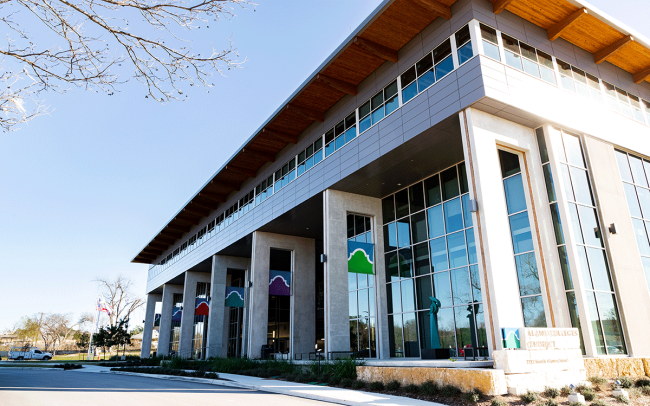You have /5 articles left.
Sign up for a free account or log in.

The Alamo Colleges District in Texas provides students with transfer information based on their desired four-year institution and major, helping them make sure all credits transfer.
Alamo Colleges District
Despite 80 percent of community college students intending to transfer, only one-third of those who started at a community college during the 2015–16 academic year successfully transferred to a four-year institution, a new report found. Just half (48 percent) of those upward transfers earned a bachelor’s degree.
To promote transfer among college students, Alamo Colleges District partners with local institutions to create detailed online transfer guides, illustrating which courses a student at any of its five colleges can complete in pursuit of their bachelor’s degree in a specific major at a specific institution.
The initiative has saved students over $370 million and cut their hours to degree by 30 credits, administrators say.
The background: Alamo Colleges administrators created a guided pathways initiative in 2015. At that time, students took an average of 92 hours to complete a 60-hour degree.
A majority of students at the colleges are part-time learners, “but even rationalizing that a majority of our students are part-time, you still didn’t want to have the data trending in that direction,” says Angela Guadian-Mendez, director of student completion.
More than 60 percent of ACD students are first generation as well, so they start out with limited access to information about transfer policies and procedures.
How it works: Every Transfer Advising Guide (TAG) is specific to the institution and the major, making each of the 3,000 guides unique. The transfer guides are different from 2+2 programs, which come with disclaimers and red tape that may stop a student’s credits from transferring, Guadian-Mendez says.
Around 8 percent of bachelor’s degree graduates who started at a community college in 2007 followed a 2+2 pattern, with more taking 2+3 (17 percent), 3+3 (13 percent) or 2+4 (11 percent) years to earn their bachelor’s degrees, according to National Student Clearinghouse data.
The TAGs, on the other hand, highlight each ACD course and the course it fulfills at the transfer university, as well as how many credit hours will transfer. The TAG also denotes courses that ACD faculty and outside partners believe are critical to the student’s academic success.
For example, a 2018 guide for majoring in journalism at Texas A&M University at Kingsville tells students they should complete COMM 1307, Introduction to Mass Communication, to set them up academically as well as fulfill a Texas Higher Education Coordination Board curriculum requirement.
At the bottom of the TAGs, staff provide additional information including contact details for the partner university’s advising center, its degree requirements and the most recent course catalog so students can plan out their degree progression.
TAGs are built on a two-year timeline, providing the fastest path to a university of choice. To support students in their degree progression, any student who completes 18 to 24 hours during the academic year is eligible for up to nine free credit hours over the summer session.
Creating a guide: ACD has a memorandum of understanding with 21 institutions that say once a student starts a TAG, their path is protected for the next five years, so all the courses will transfer and count toward their degree. The partner universities also sign off on the TAGs, adding another level of transparency and support for this work.
“One of the main differences between our transfer guides and a 2+2 is we reverse math,” Guadian-Mendez says. “And what that means is, we do not start or end with our community college degree requirements; we begin and end with the degree requirements at each of our partner institutions.”
Staff at ACD plan all 120 credit hours for the road maps they provide students, looking at course catalogs through a critical lens. Sometimes staff take feedback to university partners, highlighting areas of concern, including when documents don’t align on transfer courses.
“The intent of the MOU is that Alamo Colleges will do the heavy lifting … and in review, the universities are asked to not only review the information that we put together but put all the key players in the same room so that we can have negotiations and conversations,” Guadian-Mendez says.
The challenges: Creating TAGs is resource-heavy, with ACD employing several dedicated staffers simply to review and recreate TAGs each year, because university course catalogs are constantly updating and the district’s five colleges are independently accredited.
Each year, the district invests between $600,000 and $700,000 in TAGs alone.
“It’s well worth the investment, because the return on investment of our community is massive,” says George Railey Jr., vice chancellor for academic success at ACD.
While the TAGs can be helpful in reducing the number of credits students lost, the lack of commonality across degree programs means some students will still miss out.
“If you, for instance, take biology, we had 21 universities with 21 different degree requirements for all 120 hours,” Guadian-Mendez says. “It’s difficult for the student to have to know on day one what they want to do and where they want to go. Because if they don’t, then they’re already facing an uphill battle as part of transfer.”
Sometimes the district has to step in and intercede for the student when a partner university tries to deny credits, but ACD staff are committed to doing that work so it doesn’t fall onto their students’ shoulders.
Whom it benefits: The TAGs are helpful for three kinds of students, whom Guadian-Mendez categorizes by stoplight colors: red, yellow and green.
- Green students know what they want to study and where they want to transfer, so they’re able to hit the ground running, working alongside their adviser to meet TAG requirements as quickly as possible.
- Yellow students, who may have some idea of their field of study or institution of choice, can complete one of 21 TAGs that fulfill common core requirements to give them space to explore career opportunities without losing money and time. Advisers check in with those students at key credit-hour benchmarks (15, 30, 45 credit hours).
- Red students, who have no idea why they’re enrolled in college, can also be shepherded through the TAGs, taking between nine and 18 credit hours that apply to a majority of programs and institutions, allowing them to spend some time in college before they need to make a decision.
All students can also shop between ACD’s partner universities, identifying the institutions with the greatest flexibility in their credit acceptance or those that accept credits students have already taken.
The impact: When the initiative launched, ACD partnered with seven four-year institutions in the southern Texas region, which has since scaled to 21, with a long waiting list of other partners who want to come onboard.
Students who successfully transfer have a higher GPA and higher retention compared to years prior. More ACD students are enrolled full-time as well, increasing from a 20-80 split between full-time and part-time to 32-68. In 2015, it took students around 92 hours to complete a 60-hour degree; as of 2022, native students (those who start and end at ACD) average 65.1 hours for a 60-hour degree.
In 2020, students who followed seamless transfer pathways—or those that allow for zero loss of credit hours—collectively saved up to $374 million on tuition.
The transfer guides have created some visibility into the different transfer processes, as well. They’ve benefited college leaders advocating at the state level for more standardized courses or degree programs that transfer across institutions. The comparison of credit transfer availability has also encouraged universities to incentivize transfer to their universities with flexible policies and scholarships.
Alamo Colleges is looking to create a database to store TAG information, because existing transfer databases are faulty and do not account for the nuances of the institutions and the student. The district hopes to have funding and a prototype developed by this fall before inviting partners to beta test it.
A database, in addition to helping advisers and students, will provide data visibility across partner institutions and other stakeholders so they can better evaluate transfer.
Seeking stories from campus leaders, faculty members and staff for our Student Success focus. Share here.




